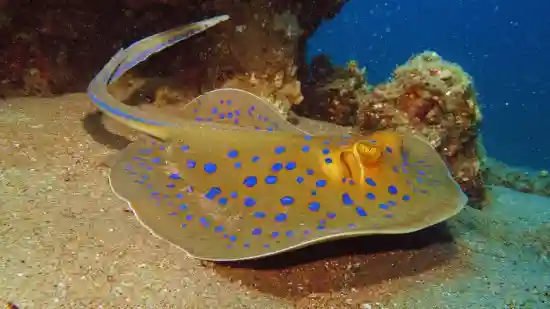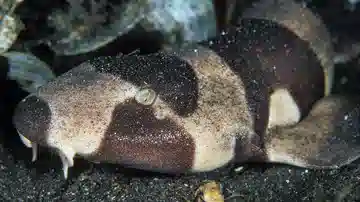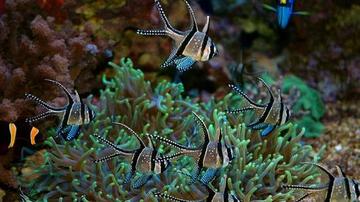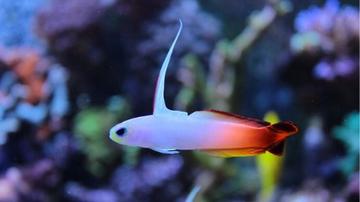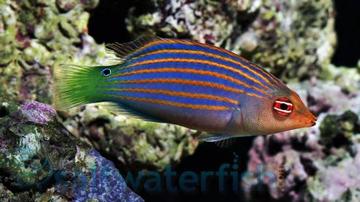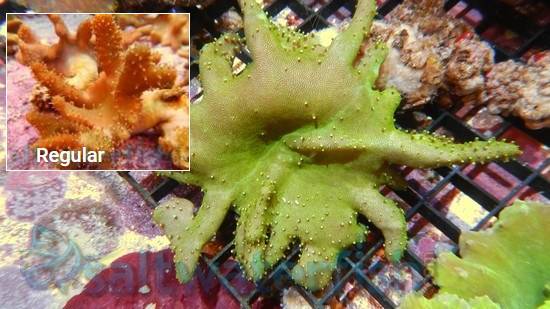Expert Only
Blue Spot Stingray: Round
Taeniura lymma
(0 Reviews)
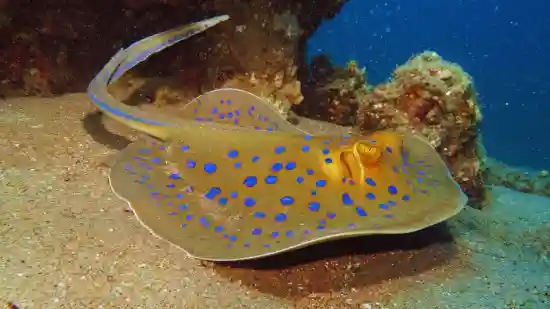
Expert Only
Blue Spot Stingray: Round
Taeniura lymma
(0 Reviews)
{{ item.name }}
Size: {{ item.extra_field_3 }}
${{ getFormattedPrice(item.saleprice) }} ${{ getFormattedPrice(item.price) }}
To join the waiting list, click here
Free Shipping
With
$199.00
or more in Marine Life.
More details...
Blue Spot Stingray: Round Care Facts
There are no key facts available for this product.
The Blue Dot Stingray requires sand substrate, as its abdomen is easily scratched. It likes to cover itself with the soft substrate as camouflage. Once acclimated, it will eat any invertebrates in the tank. The tail spine is venomous and only used for protection. Caution should be taken when netting it, or when it is not visible and maintenance is performed in the aquarium. It should never be exposed to copper-based medications.
Due to its lack of hardiness when introduced into an aquarium, it should only be kept by an experienced hobbyist.
Blue Spot Stingray (Taeniura lymma) - A Comprehensive Guide for Saltwater Marine Aquariums
This comprehensive guide is designed to provide essential information for saltwater marine aquarium enthusiasts interested in the care and maintenance of the Blue Spot Stingray (Taeniura lymma). Covering various aspects of their natural habitat, reef compatibility, size, lifespan, dietary requirements in captivity, aquaculture availability, sexual dimorphism, symbiotic relationships, juvenile versus adult coloration, temperament, tank specifications, and water conditions, this guide will assist both novice and experienced aquarists in successfully keeping this species in a home aquarium.
Habitat of the Blue Spot Stingray
The Blue Spot Stingray, scientifically known as Taeniura lymma, is primarily found in the Indo-Pacific region, particularly in the waters of the Indian Ocean and the western Pacific Ocean. They prefer a habitat of coral reefs, lagoons, and shallow coastal waters with a sandy substrate.
Reef Compatibility of the Blue Spot Stingray
The Blue Spot Stingray is not considered reef-safe due to their foraging behavior and potential to disturb the substrate. They have specialized teeth adapted for crushing hard-shelled prey, and this natural behavior can result in unintended damage to corals and other invertebrates in a reef tank. Therefore, it is strongly recommended to house them in a fish-only or FOWLR (Fish Only With Live Rock) setup.
Size of Blue Spot Stingrays:
Blue Spot Stingrays are known for their relatively modest size compared to other stingray species. When fully grown, they typically reach a disc width of around 16 inches top (30 centimeters). Nevertheless, it is crucial to consider their size when planning an aquarium setup, as they require sufficient swimming space.
Lifespan of the Blue Spot Stingray
With proper care and a suitable environment, Blue Spot Stingrays can live for a considerable period in captivity. Their lifespan commonly ranges from 5 to 10 years or more.
Diet in Captivity of the Blue Spot Stingray
Blue Spot Stingrays are carnivorous predators with a diverse diet. In captivity, their diet should mainly consist of:
- Crustaceans: Offer a variety of crustaceans such as shrimp, crabs, and other marine invertebrates. These are essential to meet their nutritional needs and maintain their health.
- Small Fish: Incorporate small fish into their diet to mimic their natural feeding habits.
- Mollusks: Providing mollusks like clams and squid can also contribute to a balanced diet.
- Pellet Foods: High-quality commercial sinking pellets designed for rays can be offered, but they should be separate from the primary diet.
Aquaculture Availability of the Blue Spot Stingray
Blue Spot Stingrays are not commonly available through aquaculture. Most specimens in the aquarium trade are sourced from the wild. When acquiring Blue Spot Stingrays, purchasing them from reputable suppliers who adhere to ethical and sustainable collection practices to minimize the impact on wild populations is essential.
Sexual Dimorphism of the Blue Spot Stingray
Sexual dimorphism in Blue Spot Stingrays is not easily discernible when they are young through physical characteristics, making it challenging to differentiate between males and females. Once they reach sexual maturity you can tell the males from females by external gonads near their tail base called claspers.
Symbiotic Relationships of the Blue Spot Stingray
Blue Spot Stingrays often form symbiotic relationships with cleaner fish and shrimp in their natural habitat. Cleaner species help keep their skin free from parasites by feeding on them. However, replicating this relationship in captivity can be challenging, and compatibility with cleaner species should be cautiously approached.
Juvenile vs. Adult Coloration of the Blue Spot Stingray
Juvenile Blue Spot Stingrays are characterized by vibrant blue spots on their dorsal surface, which are more pronounced and visually striking than in adults. As they mature, the intensity of the blue spots may decrease, and the overall coloration may become more subdued.
Temperament of the Blue Spot Stingray
Blue Spot Stingrays are generally peaceful and docile, with a low likelihood of displaying aggression towards other large tank mates. However, they have specialized feeding habits that involve digging in the substrate, so tank mates should be selected carefully to avoid conflicts.
Suitable Tank Mates for the Blue Spot Stingray
Here are five compatible tank mates that can potentially coexist peacefully with Blue Spot Stingrays:
- Eels (Anguilliformes) : Certain Eel species, such as the Snowflake Moray (Echidna nebulosa), can be suitable tank mates if the tank size permits.
- Lionfish (Pterois spp.): Lionfish are generally slow-moving and can coexist with Blue Spot Stingrays if they are not overly aggressive.
- Groupers (Serranidae): Some larger grouper species can be compatible if they are of similar size and temperament.
- Cleaner Wrasse (Labroides dimidiatus): Cleaner Wrasse species may coexist with Blue Spot Stingrays and form symbiotic relationships with them by cleaning them of parasites.
- Squirrelfish (Holocentridae): Squirrelfish are good tanks mates as they are not overly aggressive and will eat the same diet as the stingrays.
Tank Requirements for the Blue Spot Sting
Creating an ideal environment is essential for the well-being of Blue Spot Stingrays. Here are some essential tank requirements:
- Minimum Tank Size: A tank with a capacity of at least 300 gallons is recommended to provide sufficient swimming space for a fully-grown Blue Spot Stingray.
- Substrate: Use a soft, sandy substrate to prevent abrasions to their delicate underside as they often bury themselves partially.
- Aquascaping: Incorporate live rock structures and caves to provide hiding spots and create a visually appealing environment. Be sure to secure any decor to prevent accidental collapses.
- Water Conditions: Maintain stable water conditions within the following parameters:
- pH: Keep the pH level between 8.1 and 8.4.
- Salinity: Maintain a salinity level of 1.020 to 1.025.
- Water Temperature: Keep the water temperature in the range of 74°F to 78°F (23°C to 26°C).
- Water Flow: Provide moderate water flow, as Stingrays prefer areas with gentle to mild currents.
Why People Should Buy Stingrays from Saltwaterfish.com:
When considering the purchase of a Blue Spot Stingray, sourcing it from reputable suppliers like Saltwaterfish.com ensures the highest quality and ethical standards. These suppliers prioritize the well-being of the fish and employ sustainable practices that protect natural marine ecosystems. Purchasing from such sources benefits the aquarium and contributes to the conservation of marine life.
In conclusion, the Blue Spot Stingray is a captivating addition to saltwater marine aquariums, known for its intricate patterns and engaging behavior. By adhering to the guidelines outlined in this comprehensive guide and sourcing these Stingrays from ethical suppliers, aquarists can enjoy the presence of this remarkable species while promoting responsible and sustainable practices within the hobby.
Expert Only: Items designated as expert only require special care such as a species specific environment, special diet or care, and an expert level, experienced aquarist. Not for beginners. Expert Only items qualify for our live arrival guarantee only, and are exempt from our extended 8 day guarantee.
Currently Blue Spot Stingray: Round does not have any reviews.


